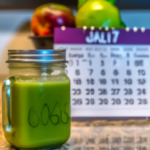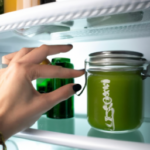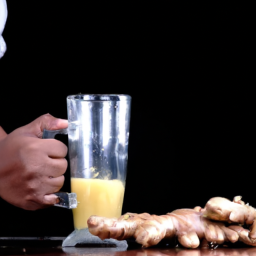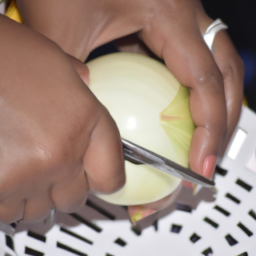As someone who loves making and drinking green juice, I often wonder how long it stays fresh before going bad. It’s important to keep in mind that drinking spoiled juice can be risky for your health. The freshness of green juice is influenced by factors like the types of fruits and vegetables used, how it’s prepared, and how it’s stored.
In this article, I will explore these factors and provide tips for extending the shelf life of green juice. Green juice is a popular health drink made with various greens, such as kale, spinach, and celery, and often mixed with fruits like apples, pears, and oranges. The juice is rich in vitamins, minerals, and antioxidants, making it a nutritious way to get your daily dose of greens.
However, since green juice is made from fresh produce, it can spoil quickly if not stored properly. In this article, I will answer the question, ‘how long is green juice good for?’and provide guidelines on how to properly store and handle your green juice to ensure it stays fresh and safe to consume.
Key Takeaways
- Freshly made green juice has the highest nutrient intake and is best consumed within 24 hours.
- Refrigerated green juice can last up to 72 hours, but longer sitting time results in nutrient loss.
- Frozen green juice can last several months but may lose flavor and texture during thawing.
- Proper storage and handling of green juice, such as keeping it refrigerated in an airtight container and adding lemon juice to prevent bacterial growth, is important to avoid waste and maximize health benefits.
Factors Affecting Green Juice Shelf Life
When it comes to green juice, factors like temperature, oxygen exposure, and acidity levels can all impact how long it’s good for. One of the main factors affecting the shelf life of green juice is juice oxidation. When juice is exposed to air, it starts to oxidize and lose its nutrients. This process can happen quickly, especially if the juice is not consumed immediately or stored improperly.
Temperature control is also crucial in determining how long green juice will last. If the juice is kept at room temperature, it will spoil faster than if it is refrigerated. Ideally, green juice should be consumed within 24 hours of being made to ensure maximum nutrient content and freshness. However, if properly stored in an airtight container and refrigerated at a consistent temperature, green juice can last up to 72 hours.
These factors should be taken into consideration to ensure that the maximum nutritional benefits are obtained from green juice. Factors such as juice oxidation and temperature control can significantly impact the shelf life of green juice. It is important to store green juice in an airtight container and keep it refrigerated to increase its longevity.
In the next section, we’ll discuss how long green juice is good for and when it should be consumed.
How Long is Green Juice Good For?
As someone who frequently makes green juice at home, I often wonder how long it will stay fresh and retain its nutritional value.
Freshly made green juice is best consumed within 24 hours to ensure maximum nutrient intake, as enzymes and vitamins begin to break down soon after juicing.
Refrigerated green juice can last up to 72 hours, but it’s important to note that the longer it sits, the more nutrients it loses.
Alternatively, frozen green juice can last several months, but it may lose some of its flavor and texture during the thawing process.
Freshly Made Green Juice
Sipping on a refreshing glass of freshly made green juice is like treating your body to a spa day. The vibrant, chlorophyll-rich concoction is packed with essential vitamins, minerals, and antioxidants that can help boost your immune system, improve digestion, and promote healthy skin.
When it comes to juicing, the key is to use the best greens for juicing. Kale, spinach, celery, cucumber, and parsley are all great options that are low in sugar and high in nutrients. Juicing benefits are numerous, but it’s important to note that freshly made green juice is best consumed immediately after juicing.
The longer the juice sits, the more it loses its nutritional potency. This is because the enzymes in the juice begin to break down, causing the juice to oxidize and lose its nutritional value. So, if you’re looking to reap the maximum benefits of juicing, it’s best to drink your green juice right after making it.
However, if you need to store your juice for later, refrigerated green juice can still provide some health benefits.
Refrigerated Green Juice
Refrigerated green juice can still pack a nutritional punch, providing a convenient and healthy option for those on-the-go. Here are four things to keep in mind when it comes to refrigerating your green juice:
-
The shelf life of refrigerated green juice can vary depending on the ingredients, but generally it can last up to 72 hours.
-
To ensure the maximum nutritional benefits, it’s recommended to store the juice in an airtight container.
-
It’s important to keep the juice cold at all times and avoid exposing it to direct sunlight or heat.
-
While refrigerated green juice can be a great addition to a juice cleanse, it’s important to still incorporate whole fruits and vegetables for a balanced diet.
When it comes to juicing, the benefits are endless. From increased energy levels to clearer skin, juicing has become a popular trend for those looking to improve their health. However, some may wonder if frozen green juice is just as beneficial as freshly made or refrigerated juice.
Frozen Green Juice
Frozen green juice can be a convenient option for those who want to enjoy the benefits of juicing but may not have the time or resources to make it fresh every day. It’s important to use proper blending techniques to ensure the consistency and texture is not compromised when freezing green juice.
One common method is to blend the ingredients together, pour the mixture into ice cube trays, freeze, and then transfer the frozen cubes into a freezer-safe container. Another advantage of freezing green juice is the ability to experiment with different flavor variations. For example, you can add fruits or herbs to the green juice before blending and freezing to create unique flavor combinations.
However, it’s important to note that frozen green juice may not have the same nutrient content as fresh juice, as some vitamins and enzymes may be lost during the freezing process. In the next section, I will discuss some signs of spoiled green juice and how to properly store and handle it to ensure it stays fresh.
Signs of Spoiled Green Juice
If you’re wondering how to tell if your green juice has gone bad, you’ll want to keep an eye out for any changes in color, texture, or smell. Common contaminants that may cause spoilage include bacteria, mold, and yeast.
Consuming spoiled green juice can have negative effects on health, such as stomach upset, diarrhea, and food poisoning. It’s important to discard any green juice that has a foul odor, slimy texture, or a color that has changed from its original green hue.
To avoid wasting green juice and money, there are some tips for extending its shelf life. One way is to store it in an airtight container and keep it refrigerated below 40°F. Another method is to add a small amount of ascorbic acid or lemon juice to prevent oxidation.
Additionally, freezing green juice in ice cube trays can be a convenient way to have pre-portioned servings ready to go. By following these tips, you can enjoy your green juice for a longer period of time and reduce the amount of food waste.
Tips for Extending Green Juice Shelf Life
By properly storing and preserving your green juice, you can savor every sip and avoid any unpleasant surprises. One of the best tips for extending green juice shelf life is to use an airtight container. This can help keep out air and moisture, which can lead to oxidation and spoilage of the juice.
Glass jars or bottles with tight-fitting lids are great options for storing green juice. Another technique is to add lemon juice to the green juice. The citric acid in lemon juice can help prevent bacterial growth and slow down the oxidation process.
Another way to extend the shelf life of green juice is to freeze it in ice cube trays. This way, you can enjoy the juice for longer without worrying about it going bad. With these tips and techniques, you can ensure that your green juice stays fresh and delicious for as long as possible.
In the subsequent section, we’ll discuss how to properly store green juice to maximize its shelf life.
How to Properly Store Green Juice
Now that we’ve discussed some helpful tips for prolonging the shelf life of your green juice, let’s talk about how to properly store it. Juice storage tips are crucial to prevent spoilage and ensure that you get the most out of your healthy beverage.
Here are some helpful tips for storing your green juice properly:
- Store immediately: As soon as you make your green juice, store it in an airtight container to prevent oxidation and bacteria growth.
- Keep it cold: Store your green juice in the refrigerator at a temperature of 39°F (4°C) or below.
- Use glass containers: Glass containers do not contain harmful chemicals that can leach into your juice.
- Consume within 72 hours: While green juice can last up to 5 days, it’s best to consume it within 72 hours to ensure that it’s fresh and packed with nutrients.
By following these simple juice storage tips, you can prevent spoilage and ensure that your green juice stays fresh and delicious.
However, if your green juice does spoil, there are some potential health risks to be aware of. Let’s discuss those in the next section.
Health Risks of Drinking Spoiled Green Juice
Drinking spoiled green juice can pose serious health risks, causing stomach discomfort and potentially leading to food poisoning symptoms such as nausea, vomiting, and diarrhea, leaving you feeling weak and miserable. It’s important to be able to detect if green juice has spoiled and take preventative measures to ensure that you don’t consume it.
One way to detect if green juice has spoiled is by checking its smell and appearance. If the juice has a sour or rancid smell, or if it has changed in color or consistency, then it may have gone bad. To prevent green juice from spoiling, it’s important to store it properly by keeping it in an airtight container in the refrigerator and consuming it within 24-48 hours of making it.
By following these prevention tips, you can avoid the health risks associated with drinking spoiled green juice. Transitioning into the subsequent section about recycling and disposing of green juice, it’s important to note that proper disposal of unused or spoiled green juice is equally as important as proper storage and consumption.
Recycling and Disposing of Green Juice
When it comes to green juice, one of the best ways to reduce waste and promote sustainability is through proper recycling and disposal. This can involve composting leftover pulp and vegetable scraps, ensuring that plastic bottles are disposed of properly, and reusing ingredients whenever possible.
By adopting these practices, we can not only reduce our environmental impact but also make the most out of our green juice ingredients.
Composting
Transform your leftover green juice into nutrient-rich compost for your garden by adding it to your compost pile. Composting is a sustainable living practice that involves breaking down organic materials into a soil-like substance that can be used to nourish plants.
When you add green juice to your compost pile, you are providing it with valuable nutrients that will benefit your plants in the long run. Composting is an environmentally friendly way to reduce waste and create a natural fertilizer for your garden. By adding green juice to your compost pile, you are diverting it from the landfill and turning it into a valuable resource.
Proper composting requires a balance of green materials, such as fruit and vegetable scraps, and brown materials, like leaves and twigs. Once your compost pile is established, it requires minimal maintenance and will continue to break down into nutrient-rich soil.
When your compost is ready, you can use it to feed your plants and promote healthy growth. In the next section, we’ll discuss the proper disposal of green juice if you don’t have a compost pile.
Proper Disposal
To dispose of your leftover green juice properly, simply pour it into the compost bin or add it to your yard waste collection bin. By doing so, you reduce the amount of waste that goes into landfills, which contributes to a healthier environment. Green juice is a great source of nutrients, but it can also be a source of waste if not disposed of properly. When green juice is thrown away with other household waste, it can release methane gas as it decomposes in landfills. This gas is a major contributor to climate change and has a significant environmental impact.
In order to minimize waste and reduce your environmental impact, it is important to properly dispose of your green juice. By doing so, you are not only reducing the amount of waste that goes into landfills but also contributing to the creation of nutrient-rich compost that can be used to enrich soil for gardening. Speaking of reusing ingredients, let’s explore how we can get the most out of our green juice ingredients.
Reusing Ingredients
Let’s explore how we can make the most of our leftover ingredients from green juice by reusing them in creative and delicious ways. Instead of throwing away the pulp and leftover greens, we can incorporate them into other recipes and drinks. Here are three ways to reuse leftover ingredients:
-
Add the pulp to smoothies: The pulp from green juice can add a lot of fiber and nutrients to a smoothie. Simply blend the pulp with some frozen fruit and almond milk for a delicious and nutritious drink.
-
Make vegetable broth: The leftover greens and vegetables can be used to make a flavorful vegetable broth. Simply simmer the greens and vegetables in water for a few hours, strain the mixture, and use the broth in soups or stews.
-
Use the greens in salads: The leftover greens from green juice can be used in salads as a base or as a topping. They add a lot of nutrients and flavor to any salad.
Incorporating recycled ingredients in green juice has many benefits. It not only reduces food waste, but it also adds more nutrients and fiber to your diet. By reusing leftover ingredients, we can create more sustainable and healthy habits in our daily lives.
Frequently Asked Questions
Can I freeze green juice to extend its shelf life?
I’ve found that freezing green juice can extend its shelf life, but be aware that nutrient loss may occur. However, it’s still a great option for those who want to enjoy the benefits of green juice beyond its typical expiration date.
How often should I consume green juice to maximize its health benefits?
To maximize the health benefits of green juice, I recommend drinking it in the morning on an empty stomach. Aim for 8-16 ounces daily, depending on your individual needs. Consuming it consistently is key for long-term benefits.
Can I mix different types of greens when making green juice?
I love experimenting with different mixing techniques and flavor combinations when making green juice. It’s important to balance bitter and sweet flavors and not overdo it with strong-tasting greens.
Can I add other ingredients, like fruits or spices, to my green juice?
Yes, you can add supplements, fruits, and spices to your green juice to experiment with flavors and boost nutritional value. However, it is important to research proper ratios and consult with a healthcare professional before adding supplements.
Can I drink green juice past its expiration date if it looks and smells okay?
As tempting as it may be, drinking expired juice can pose health risks. Even if it looks and smells okay, the freshness of the juice cannot be guaranteed. Always prioritize food safety and dispose of expired juice properly. Remember, "when in doubt, throw it out."
Conclusion
In conclusion, as a lover of green juice, it’s important to know how long it’s good for to avoid any potential health risks. Various factors affect the shelf life of green juice, including the ingredients used, the storage method, and exposure to air and light.
Generally, green juice can last for up to 72 hours when stored properly in the refrigerator. However, signs of spoilage should be closely monitored, such as changes in color, texture, and odor.
To extend the shelf life of green juice, it’s recommended to store it in an airtight container, keep it away from direct light, and consume it as soon as possible. It’s also important to properly dispose of any spoiled juice to prevent contamination.
Always be mindful of the potential risks of consuming spoiled juice, such as foodborne illness, and prioritize your health and well-being. Remember, a healthy body is a happy body, so drink up and enjoy the benefits of green juice!
Ilana has been a vegan for over 10 years. She originally made the switch for health reasons, but soon found herself becoming more and more passionate about the ethical and environmental implications of a vegan lifestyle. Ilana is the author of The Graceful Kitchen, a blog all about veganism. She loves to cook up delicious and nutritious vegan meals, and share her recipes with others who are interested in leading a cruelty-free life. Ilana is also a strong advocate for using whole foods as the foundation of a healthy diet, and believes that going vegan is one of the best ways to achieve this.
















